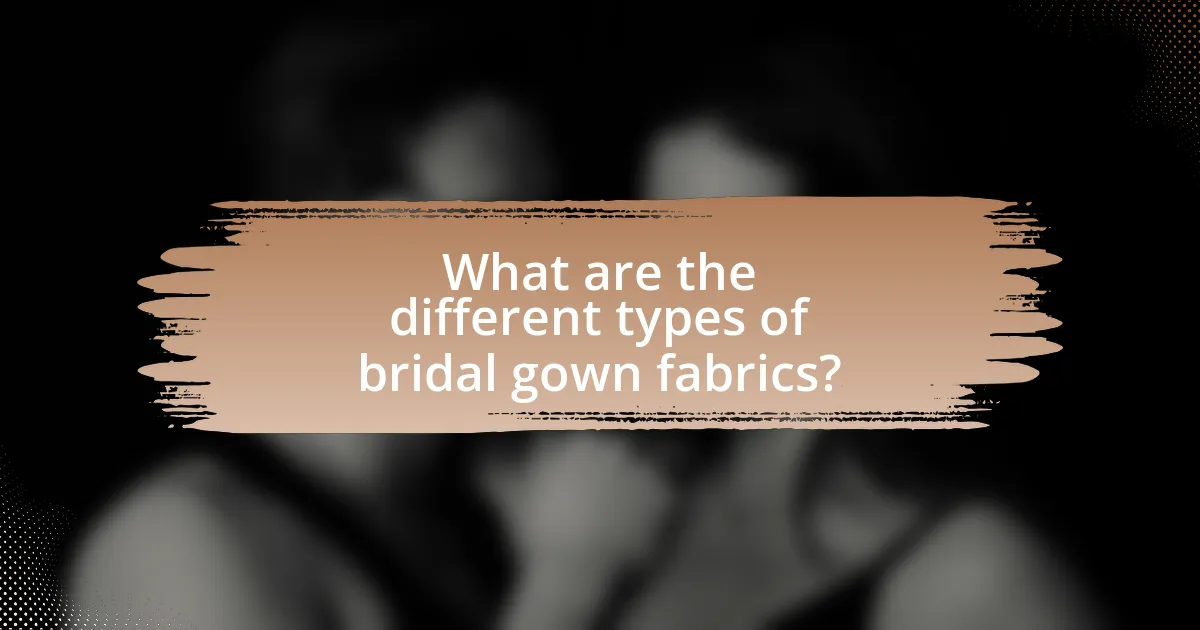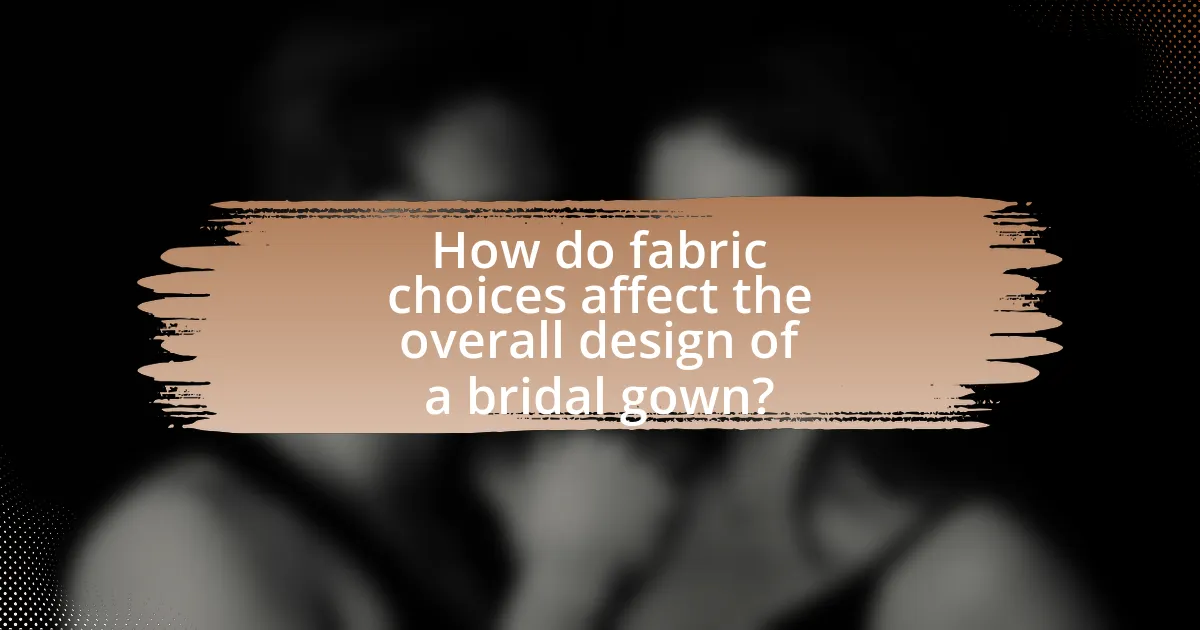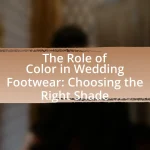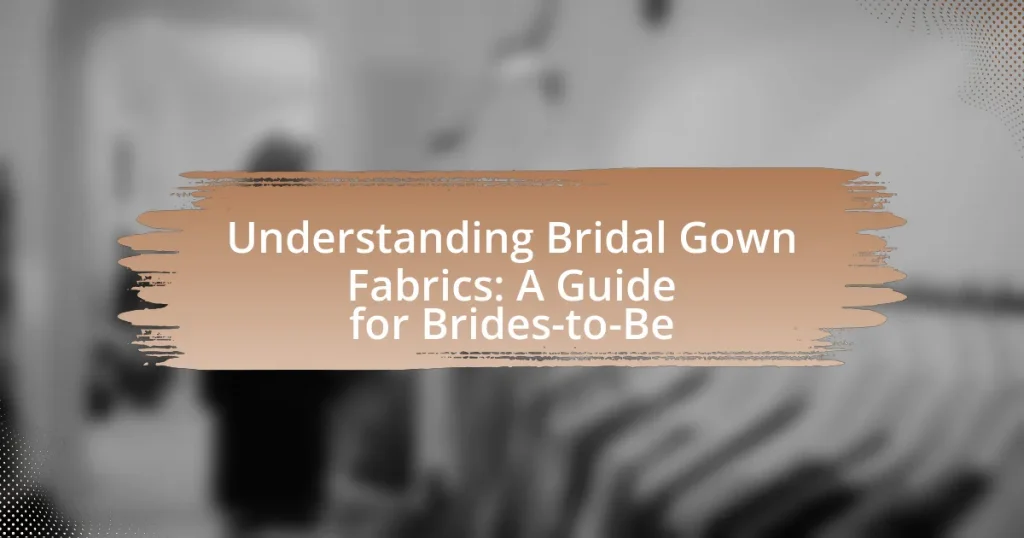The article “Understanding Bridal Gown Fabrics: A Guide for Brides-to-Be” provides an in-depth exploration of various fabrics used in bridal gown design, including satin, chiffon, lace, tulle, organza, and silk. It examines the differences between natural and synthetic fabrics, highlighting their unique characteristics, benefits, and environmental impacts. The article also discusses how fabric choices affect gown structure, silhouette, comfort, and overall design, offering practical tips for brides on selecting the best fabrics based on body type, season, and style preferences. Additionally, it addresses common mistakes to avoid when choosing gown fabrics to ensure a comfortable and aesthetically pleasing wedding attire.

What are the different types of bridal gown fabrics?
Bridal gowns are made from various types of fabrics, each offering unique characteristics and aesthetics. Common bridal gown fabrics include satin, which is known for its luxurious sheen and smooth texture; chiffon, recognized for its lightweight and flowy nature; lace, celebrated for its intricate patterns and romantic appeal; tulle, a net-like fabric often used for skirts and veils; organza, which is crisp and sheer; and silk, prized for its softness and elegance. These fabrics are chosen based on their drape, texture, and the overall look desired by the bride, making them essential in the design of bridal attire.
How do natural fabrics differ from synthetic fabrics in bridal gowns?
Natural fabrics differ from synthetic fabrics in bridal gowns primarily in their composition and characteristics. Natural fabrics, such as silk, cotton, and linen, are derived from plants or animals and typically offer breathability, softness, and a luxurious feel. In contrast, synthetic fabrics like polyester and nylon are man-made and often provide durability, wrinkle resistance, and affordability.
For instance, silk is known for its elegant drape and sheen, making it a popular choice for high-end bridal gowns, while polyester can mimic silk’s appearance at a lower cost but may lack the same level of comfort and breathability. Additionally, natural fabrics tend to be more environmentally friendly, as they are biodegradable, whereas synthetic fabrics can contribute to pollution and are less sustainable.
What are the characteristics of silk as a bridal gown fabric?
Silk is a luxurious fabric commonly used for bridal gowns due to its smooth texture, natural sheen, and elegant drape. The smooth texture of silk enhances comfort against the skin, while its natural sheen provides a sophisticated appearance that is visually appealing in wedding attire. Additionally, silk drapes beautifully, allowing for graceful silhouettes and flowing designs that can enhance the overall aesthetic of a bridal gown. Furthermore, silk is known for its breathability, making it suitable for various climates, and its durability, which ensures that the gown can withstand the rigors of a wedding day. These characteristics make silk a favored choice among brides seeking elegance and comfort in their wedding attire.
Why is cotton a popular choice for bridal gowns?
Cotton is a popular choice for bridal gowns due to its breathability, comfort, and versatility. The natural fibers of cotton allow for airflow, making it suitable for various climates, especially warmer ones. Additionally, cotton can be easily dyed and printed, offering a wide range of design options for brides. Its softness against the skin enhances comfort during long wedding ceremonies and receptions. Furthermore, cotton is a sustainable fabric option, appealing to environmentally conscious brides.
What are the most common fabric blends used in bridal gowns?
The most common fabric blends used in bridal gowns include silk and polyester, satin and silk, and lace combined with various fabrics. Silk and polyester blends offer a luxurious feel while maintaining durability, making them popular choices for bridal gowns. Satin, often made from silk or polyester, provides a smooth finish and a beautiful drape, enhancing the gown’s elegance. Lace, frequently blended with fabrics like tulle or chiffon, adds intricate detailing and texture, contributing to the overall aesthetic of the gown. These fabric combinations are favored for their balance of comfort, style, and visual appeal in bridal fashion.
How does a silk and satin blend enhance a bridal gown?
A silk and satin blend enhances a bridal gown by combining the luxurious feel of silk with the smooth, glossy finish of satin, resulting in a fabric that drapes beautifully and reflects light elegantly. This blend provides a soft texture against the skin while offering a structured silhouette that flatters various body types. Additionally, the silk component adds breathability and comfort, making it suitable for long wear during events. The satin’s sheen elevates the gown’s overall aesthetic, contributing to a sophisticated and timeless look that is often desired in bridal fashion.
What benefits do polyester blends offer for bridal gowns?
Polyester blends offer several benefits for bridal gowns, including durability, wrinkle resistance, and affordability. The durability of polyester blends ensures that the gown can withstand wear and tear, making it suitable for long events such as weddings. Additionally, the wrinkle resistance of these fabrics helps maintain a polished appearance throughout the day, reducing the need for frequent touch-ups. Furthermore, polyester blends are often more affordable than pure silk or other natural fibers, allowing brides to achieve a luxurious look without exceeding their budget. These advantages make polyester blends a popular choice among designers and brides alike.

How do fabric choices affect the overall design of a bridal gown?
Fabric choices significantly influence the overall design of a bridal gown by determining its silhouette, drape, and texture. For instance, heavier fabrics like satin and taffeta create structured designs that hold their shape, while lighter materials such as chiffon and organza allow for flowing, ethereal looks. The choice of fabric also impacts the gown’s embellishments; intricate beadwork may be more suited to a sturdy fabric that can support the weight, whereas delicate lace may require a softer base to maintain its intricate patterns. Additionally, the fabric’s color and finish can affect the gown’s visual appeal, with matte finishes providing a classic look and shiny fabrics offering a more modern aesthetic. Thus, the selection of fabric is crucial in achieving the desired style and overall impact of the bridal gown.
What role does fabric weight play in gown structure and silhouette?
Fabric weight significantly influences gown structure and silhouette by determining how the fabric drapes and holds shape. Heavier fabrics, such as satin or taffeta, provide structure and support, allowing for defined silhouettes like ball gowns or A-line dresses. In contrast, lighter fabrics, such as chiffon or organza, create a softer, flowing appearance, resulting in more ethereal silhouettes. The choice of fabric weight directly affects the gown’s overall aesthetic and functionality, as seen in bridal fashion where specific weights are selected to achieve desired styles, such as the voluminous skirts of traditional wedding dresses or the sleek lines of modern designs.
How does a heavier fabric influence the gown’s drape and flow?
A heavier fabric significantly influences a gown’s drape and flow by providing more structure and weight, which results in a more defined silhouette. This increased weight allows the fabric to fall in a way that enhances the gown’s shape, creating elegant lines and a luxurious appearance. For instance, fabrics like satin or taffeta, known for their heavier nature, tend to hold their form better than lighter materials, leading to a more dramatic and sophisticated look. Additionally, the weight of the fabric can affect how the gown moves; heavier fabrics often create a more graceful flow, as they are less likely to flutter or shift erratically, ensuring that the gown maintains its intended design during movement.
What are the advantages of lightweight fabrics for bridal gowns?
Lightweight fabrics for bridal gowns offer several advantages, including comfort, breathability, and ease of movement. These fabrics, such as chiffon, organza, and tulle, allow for better airflow, making them ideal for warm weather weddings. Additionally, their lightness contributes to a more relaxed fit, enabling brides to move freely throughout the day. The draping qualities of lightweight materials also enhance the gown’s silhouette, creating an elegant and flowing appearance. Studies show that brides often prefer lightweight options for their ability to reduce fatigue during long events, thereby improving overall enjoyment of the occasion.
How do different fabrics impact comfort and wearability?
Different fabrics significantly impact comfort and wearability in bridal gowns. For instance, natural fibers like cotton and silk are breathable and soft against the skin, enhancing comfort during long wear. In contrast, synthetic fabrics such as polyester may trap heat and moisture, potentially leading to discomfort. Additionally, the weight and drape of a fabric influence how a gown fits and moves; heavier fabrics like satin can provide structure but may restrict movement, while lighter fabrics like chiffon allow for greater ease and flow. Studies indicate that fabric choice directly affects the wearer’s experience, with breathable materials contributing to overall satisfaction during events like weddings.
What should brides consider regarding breathability in fabric selection?
Brides should prioritize natural fibers like cotton, linen, and silk for breathability in fabric selection. These materials allow air circulation, reducing heat buildup and moisture retention, which is crucial for comfort, especially during long events. For instance, cotton has a high moisture-wicking ability, making it ideal for warm weather, while silk offers a luxurious feel with decent breathability. Choosing breathable fabrics can significantly enhance the overall wearing experience, ensuring that brides remain comfortable throughout their special day.
How does fabric texture affect the overall feel of the gown?
Fabric texture significantly influences the overall feel of a gown by affecting its drape, comfort, and visual appeal. For instance, a smooth satin fabric creates a luxurious and elegant feel, while a textured lace can add depth and intricacy to the gown’s appearance. The tactile experience of the fabric also impacts how the gown feels against the skin; softer materials like chiffon provide a gentle touch, enhancing comfort, whereas stiffer fabrics like taffeta may feel more structured and formal. Additionally, the texture can influence how the gown moves; flowing fabrics allow for graceful movement, while heavier textures may restrict motion. Thus, the choice of fabric texture is crucial in determining both the aesthetic and sensory experience of wearing the gown.

What are the best practices for selecting bridal gown fabrics?
The best practices for selecting bridal gown fabrics include considering the gown’s silhouette, the season, and personal comfort. Fabrics like satin and silk provide a luxurious feel and drape well for structured designs, while lighter materials such as chiffon and tulle are ideal for flowing styles and warmer weather. Additionally, brides should assess the fabric’s weight and breathability to ensure comfort throughout the day. Choosing fabrics that complement the wedding theme and personal style is also crucial, as this enhances the overall aesthetic. For instance, lace can add a vintage touch, while modern fabrics like crepe offer a sleek appearance.
How can brides determine the best fabric for their wedding season?
Brides can determine the best fabric for their wedding season by considering the climate and temperature of the wedding date. For warmer seasons, lightweight fabrics like chiffon, organza, and tulle are ideal as they allow for breathability and comfort. In contrast, for cooler seasons, heavier fabrics such as satin, velvet, and brocade provide warmth and structure. Additionally, brides should consider the fabric’s drape and how it complements their body shape and wedding style. Research indicates that fabric choice significantly impacts comfort and overall aesthetic, making it essential for brides to align their fabric selection with seasonal conditions and personal preferences.
What fabrics are ideal for summer weddings?
Lightweight fabrics such as chiffon, linen, and cotton are ideal for summer weddings. These materials are breathable and help keep the wearer cool in warm temperatures. Chiffon is known for its airy quality and elegant drape, making it a popular choice for summer bridal gowns. Linen is highly absorbent and dries quickly, providing comfort in hot weather, while cotton offers a soft texture and is easy to care for. These fabrics not only enhance comfort but also contribute to a relaxed and stylish summer wedding aesthetic.
Which fabrics are suitable for winter weddings?
Suitable fabrics for winter weddings include velvet, satin, and brocade. Velvet provides warmth and a luxurious texture, making it ideal for colder temperatures. Satin offers a smooth finish and can be layered for added insulation, while brocade features intricate patterns and a heavier weight, perfect for winter elegance. These fabrics not only enhance the aesthetic appeal of bridal gowns but also ensure comfort during chilly weather.
What tips can help brides choose fabrics that complement their body type?
Brides can choose fabrics that complement their body type by considering the drape, weight, and texture of the material. For example, lightweight fabrics like chiffon and tulle can create a soft silhouette for brides with a petite frame, while heavier fabrics like satin and brocade can provide structure and support for curvier body types. Additionally, fabrics with stretch, such as jersey or spandex blends, can enhance comfort and fit for various shapes. Understanding how different fabrics interact with body shapes allows brides to make informed choices that enhance their natural features.
How can fabric patterns enhance or detract from a bride’s figure?
Fabric patterns can enhance or detract from a bride’s figure by influencing visual perception and silhouette. For instance, vertical stripes can elongate the body, creating a taller appearance, while horizontal patterns may widen the figure, potentially adding bulk. Additionally, intricate designs like florals or lace can draw attention to specific areas, either highlighting or camouflaging features based on their placement and scale. Research indicates that the psychology of patterns affects body image perception, suggesting that brides should choose patterns that align with their desired aesthetic and comfort level.
What are the best fabric choices for different bridal styles?
The best fabric choices for different bridal styles include satin for classic and elegant gowns, lace for vintage and romantic styles, chiffon for soft and flowing silhouettes, and tulle for whimsical and fairy-tale looks. Satin provides a luxurious sheen and structure, making it ideal for traditional ball gowns. Lace adds intricate detail and texture, perfect for vintage-inspired designs. Chiffon offers a lightweight and airy feel, suitable for bohemian or destination weddings. Tulle creates volume and a dreamy effect, often used in A-line or princess-style dresses. Each fabric enhances the specific aesthetic of the bridal style, ensuring the gown aligns with the bride’s vision.
What common mistakes should brides avoid when selecting gown fabrics?
Brides should avoid selecting gown fabrics without considering the season and venue, as this can significantly impact comfort and appearance. For instance, choosing heavy fabrics like satin for a summer outdoor wedding can lead to discomfort due to heat, while lightweight fabrics such as chiffon may not provide enough warmth for a winter event. Additionally, brides often overlook the importance of fabric drape and structure, which can affect how the gown fits and flatters their body shape. Selecting fabrics that do not complement the gown’s design can result in an unbalanced look. Lastly, brides frequently neglect to test the fabric’s feel against their skin, which can lead to irritation on the wedding day.










